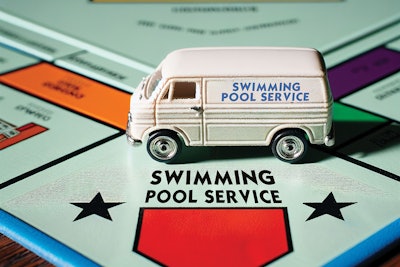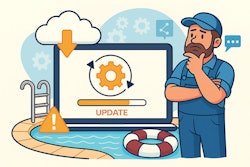

If you're in service at level, there’s a good chance you’ll one day be looking at buying or selling a route. You probably think the process is fairly straightforward — like buying title deeds in Monopoly — but there’s more to it than meets the eye.
In a recent webinar hosted by pool software company Skimmer, Director of Marketing Niki Acosta facilitated a discussion with a panel of two experienced pool service professionals to teach others how to best approach the transition period of service routes, from both ends of the deal.
Kyle Peter has spent the last six years expanding Nevergreen Pools in Sacramento, Calif., through acquisition and organic growth, going from just 12 customers to the greater part of 1,000 in that time.
Similarly, Thomas Walsh has been in the industry for six years as well, based out of Venice, Fla., with Integrity Pool Service. Together, the two of them present their best practices for going through this process, both from a pool service perspective and through the lens of a customer.
HOW DO YOU FIND ROUTES?
It’s not exactly something you can find at the store. Finding pool routes to add to your business, or finding places to spread the word about selling one of your own can be half the battle, they say. One of the biggest hurdles is the fact that the transaction is based on something intangible.
“What you’re buying is what accountants call goodwill,” Peter says. “You’re essentially buying a customer list — a piece of paper — that will become an agreement with the seller that they’re gonna do their best to transition their customers into using your services.”
After all, how do you buy something you can’t hold in your hand? The answer is through relationships, networking, and many times, a handy online listing, according to Walsh.
He’s both bought and sold routes on Craigslist or Facebook Marketplace successfully. As for networking, he recommends keeping up to date with the people in your area; most supply houses have bulletin boards, he says, and sometimes you’ll get lucky and find routes posted there as well.
Peter has had similar experience with networking to find pool routes. “People know that we’re interested in growing through acquisition,” he says. “In those instances, people can skip the searching process. If you have a reputation in your area for picking up pool routes, you might be the first one they call. Having a network of people in your area that you know and trust is always a great start.”
Once you know where to find or post your route, the next step is figuring out how you’ll finance it. Two of the methods that are discussed in the webinar include seller financing and a loan, whether it’s traditional or an SBA (Small Business Administration) loan.
The latter is decidedly difficult, Peter says, since the collateral isn’t easily presented. “A bank doesn’t see a list on paper as valuable to them,” he says. “They’re not a pool service business.”
To counter this roadblock, Peter says that some pool pros will put their homes up as collateral on recommendation from their brokers to get into the business — of course, there’s many risk factors involved that make the entire process a very personal decision. Each situation is unique and should be honored as such when considering this process.
The other method discussed, seller financing, is perhaps less risky. “You can work out a second loan with the seller,” Peter says, “or you can have a partnership with them for the time being. Sometimes we call that ‘leasing.’”
“Leasing” would include a more hands-on approach: You — the buyer — would work, providing chemicals and labor for the route. At the same time, the seller would continue to collect a portion of the income. Once a certain date or a determined amount of revenue is reached, the routes would fully transfer to the buyer.
VALUATION CONSIDERATIONS
But you can’t just buy or sell a route without considering its worth. That’s another thing you won’t find at the store; the perfect and fool-proof valuation method doesn’t exist. With Peter’s and Walsh’s advice, though, you might get pretty close.
There’s plenty of things that go into determining the value of a pool route, Walsh says. “Is it an area that’s tightly populated with other pools we’re already servicing? That would help avoid any added costs to get there.”
Proximity can be a great starting point to compare your current pool route to a potential addition, if you’re familiar with the business. But for newer pool professionals, other factors will be helpful to figure out how to make the best deal.
For example, consider what the seller is charging. If the seller has been undercharging customers, there’s some room for immediate growth in profit. “Are they charging a decent rate already?” Walsh asks. “Does it make sense in your math and formula? What’s included or not included in that?”
The size of the company from which you’re buying the route matters, too. A mismatch there can cause customers to reevaluate. Ultimately, a successful route sale is going to depend on the satisfaction of the customers, and if they suddenly find themselves working with a completely different kind of company, they may look elsewhere.
The customer perspective is important: How are they used to paying for service? Autopay? Credit card? In order to foster a smooth transition, these types of details aren’t something you’ll want to be unclear on. The communication between the customer and previous service providers can be an indicator of how you might fit with that route.
You want your practices to align with the expectations of the customer, or find a way to clearly explain how certain things will change (a separate topic that was further discussed later in the webinar), say Peter and Walsh.
Arguably one of the most important things to consider is the list of customers itself: Does the seller have email addresses for all of their customers, or some way to communicate with them? A lack thereof can be an easy deal breaker, Walsh warns.
You’ll need an open line of communication to ensure the transition of ownership goes smoothly. Potential customers want to feel comfortable with their new service so they don’t feel the urge to switch providers and put you out of a route.
CONTRACTS & AGREEMENTS
The next step in your endeavor of pool route transitions — structuring the deal, the panelists call it — is to put together a written contract or agreement to be presented to both parties of the transaction.
Alongside their own example of such a written agreement, the panelists encourage you to consult an attorney for this part of the process, especially if it’s your first time. If you’re less experienced, your chances of things not going your way could be a lot higher, they warn. You could lose out on a lot of money, end up in the middle of an agreement with someone that’s less trustworthy than you’d hope, or both.
“Almost all of the protections in these agreements are for the buyer,” Walsh says. “The seller gets the money, but the protections are for the buyer to prevent any re-marketing of the accounts during the guaranteed period.”
The details of the agreements are relatively straightforward. First, what you’ll be using is what’s called a Purchase Contract, or a Bill of Sale. It will list the accounts with all of their required data, which includes the customer’s name, their address, email address or contact information as well as their rate.
After a non-solicitation clause, the contract will list the guarantees associated with the transaction: a period of guarantee and its terms, as well as the terms for replacement accounts, which is optional.
It’s detailed, and it can be long, but it sets you up for success in the long run. “It goes back to having a good relationship with the person you’re doing the deal with,” Peter says. “You want to make sure you’re not buying someone’s late payers, bad pools, that sort of thing.”
Once you have several deals under your belt, it may feel unnecessary to write up something as explicit as a contract — as Walsh says, sometimes you might be comfortable with a handshake and an easy transition. But when you’re just breaking into the industry, or when you want to be sure to check all your boxes, the safer bet might be to refer to a written agreement.
TRANSITION STRATEGIES
Written agreements give way to how you’ll manage the physical transition of pool routes, the next step that the panelists focus on. Once a contract is written and signed between buyer and seller, the next communication should be with the customer.
“Oftentimes, we find that a lot of sellers aren’t as equipped to prepare an email communication like this,” Peter says. “They might be great in all other areas, but we want to prepare them so they can communicate this way as well.”
The sole purpose? A clear explanation to the customer about what’s happening to their pool service can make the transition go that much smoother. It can be a double-edged sword, Peter says, since there’s many details involved in a deal like this that aren’t necessary for the customer to know.
For example, the way you denote the deal matters. “You’ll want to avoid confusion,” Peter says. “Stay away from using certain terminology around homeowners. No one likes to hear that someone ‘bought their pool.’ Some may understand that language in regard to home service and the process of a contract, but it’s a good habit to stay away from using that type of language.”
Besides this, customers should be aware of other details. Some of these include the reason the seller is moving on from their route (retirement, a career change, etc.), who they’ve chosen to be their successor, and some introductory information on them — you don’t want customers feeling like a stranger is coming to service their pool, Peter says.
PRICE INCREASES
When it comes to the end of the transaction and you’re in the thick of transitioning between seller and buyer, both Peter and Walsh advise waiting at least a few months before dishing out a price increase to your new customers. Better to explain to customers that their rates will stay the same for the time being, until an eventual increase.
“I do a lot of modest price increases as opposed to one bigger one,” Walsh says. “Over the last year and a half to two years, I’ve gotten most of my customers used to an annual increase.”
The key is to look at it from the customer’s perspective, Peter explains. “If we buy pools that are listed under market value and give them an increase to something closer to market value, their alternatives are to search online and what-have-you to find something different. When they see that our competitors are similarly priced or more expensive, they’ll stay with our service.”
The process can seem long and arduous, but Peter’s and Walsh’s breakdown of each step makes it digestible for each party involved — whether you’re a new buyer coming into the industry, a soon-to-be retiring service pro, or anywhere in between. When you know enough about each step and make careful, informed decisions, you can be well on your way to a successful transaction, and perhaps even a local monopoly in pool service.
This article first appeared in the January 2025 issue of AQUA Magazine — the top resource for retailers, builders and service pros in the pool and spa industry. Subscriptions to the print magazine are free to all industry professionals. Click here to subscribe.












































